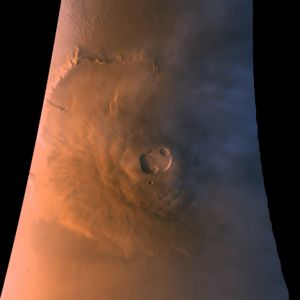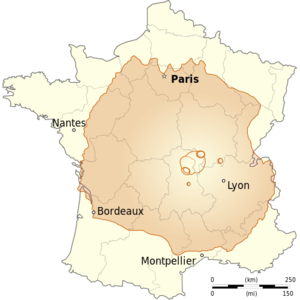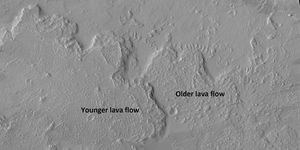Difference between revisions of "Olympus Mons"
(→Caves: added ref) |
(added info and ref about glaciers) |
||
| Line 16: | Line 16: | ||
The typical atmospheric pressure at the top of Olympus Mons is about 12% of the average Martian surface pressure.<ref name="stanford">[http://www-star.stanford.edu/projects/mgs/tps-public.html Public Access to Standard Temperature-Pressure Profiles]</ref> | The typical atmospheric pressure at the top of Olympus Mons is about 12% of the average Martian surface pressure.<ref name="stanford">[http://www-star.stanford.edu/projects/mgs/tps-public.html Public Access to Standard Temperature-Pressure Profiles]</ref> | ||
Olympus Mons is an unlikely landing location for automated space probes in the near future. The high elevations preclude parachute-assisted landings because of insufficient atmospheric thickness to slow the spacecraft down. Moreover, Olympus Mons stands in one of the dustiest regions of Mars. A mantle of fine dust covers much of the terrain, obscuring the underlying bedrock and possibly making rock samples hard to come by. The dust layer would also likely cause severe maneuvering problems for rovers.<ref>https://en.wikipedia.org/w/index.php?title=Olympus_Mons&action=edit§ion=1</ref> | Olympus Mons is an unlikely landing location for automated space probes in the near future. The high elevations preclude parachute-assisted landings because of insufficient atmospheric thickness to slow the spacecraft down. Moreover, Olympus Mons stands in one of the dustiest regions of Mars. A mantle of fine dust covers much of the terrain, obscuring the underlying bedrock and possibly making rock samples hard to come by. The dust layer would also likely cause severe maneuvering problems for rovers.<ref>https://en.wikipedia.org/w/index.php?title=Olympus_Mons&action=edit§ion=1</ref> | ||
| + | |||
| + | As with tall mountains on the Earth, there has been much snowfall on Olympus Mons. Scientists see much evidence for glaciers.<ref name="Basilevsky, A. 2006">{{Cite journal|author=Basilevsky, A. |date=2006 |title=Geological recent tectonic, volcanic and fluvial activity on the eastern flank of the Olympus Mons volcano, Mars |journal=Geophysical Research Letters |volume=33 |issue=13 |pages=13201, L13201 |doi=10.1029/2006GL026396 |bibcode = 2006GeoRL..3313201B |last2=Werner |first2=S. C. |last3=Neukum |first3=G. |last4=Head |first4=J. W. |last5=Van Gasselt |first5=S. |last6=Gwinner |first6=K. |last7=Ivanov |first7=B. A. }}</ref> | ||
| + | |||
[[Image:Olympus_Mons.jpg|thumb|right|300px|Olympus Mons as seen by [[Mars Global Surveyor]]]] | [[Image:Olympus_Mons.jpg|thumb|right|300px|Olympus Mons as seen by [[Mars Global Surveyor]]]] | ||
Revision as of 08:24, 14 February 2018
Olympus Mons is a dormant shield volcano in the Tharsis region. It is the highest point on Mars. By one measure, it has a height of nearly 22 km (13.6 mi or 72,000 ft).[1] Olympus Mons stands about two and a half times as tall as Mount Everest's height above sea level. It is the youngest of the large volcanoes on Mars. It is currently the largest volcano discovered in the Solar System and had been known to astronomers since the late 19th century as the albedo feature Nix Olympica (Latin for "Olympic Snow"). Its mountainous nature was suspected well before space probes confirmed its identity as a mountain.[2]
The volcano is located in Mars's western hemisphere at approximately 18.65 N and 226.2 E, just to the northwestern edge of the Tharsis bulge.[3] The western portion of the volcano lies in the Amazonis quadrangle and the central and eastern portions in the Tharsis quadrangle.
Olympus Mons probably has the same composition to most of the dark areas on Mars. These dark areas were formed by volcanic eruptions. The surface of Mars, including Olympus Mons is basalt of a type (tholeiites) similar to that of Earth's oceanic crust. This is the general conclusion drawn from Martian meteorites, analyses of soils and rocks at robotic landing sites, and information gathered with orbiting spacecraft.[4] [5]
Lava flows of this composition would have displayed low viscosity, a watery flow that would have produced a volcano with a very gradual slope.[6]
High-altitude clouds frequently drift over the Olympus Mons summit, and airborne Martian dust is still present.[7] The typical atmospheric pressure at the top of Olympus Mons is about 12% of the average Martian surface pressure.[8] Olympus Mons is an unlikely landing location for automated space probes in the near future. The high elevations preclude parachute-assisted landings because of insufficient atmospheric thickness to slow the spacecraft down. Moreover, Olympus Mons stands in one of the dustiest regions of Mars. A mantle of fine dust covers much of the terrain, obscuring the underlying bedrock and possibly making rock samples hard to come by. The dust layer would also likely cause severe maneuvering problems for rovers.[9]
As with tall mountains on the Earth, there has been much snowfall on Olympus Mons. Scientists see much evidence for glaciers.[10]

References:
- ↑ "Morphometric Properties of Martian Volcanoes" (2004). J. Geophys. Res. 109. doi:. Bibcode: 2004JGRE..109.3003P.
- ↑ Patrick Moore 1977, Guide to Mars, London (UK), Cutterworth Press, p. 96
- ↑ https://planetarynames.wr.usgs.gov/Page/MARS/target
- ↑ McSween Jr., H. Y., Taylor, G. J., and Wyatt, M. B. 2009. Elemental Composition of the Martian Crust. Science, v. 324(5928), p.736-739, doi: 10.1126/science.1165871.
- ↑ http://www.psrd.hawaii.edu/May09/Mars.Basaltic.Crust.html
- ↑ https://en.wikipedia.org/w/index.php?title=Olympus_Mons&action=edit§ion=1
- ↑ Hartmann, W.K. A Traveler’s Guide to Mars: The Mysterious Landscapes of the Red Planet. Workman: New York, 2003, p. 300.
- ↑ Public Access to Standard Temperature-Pressure Profiles
- ↑ https://en.wikipedia.org/w/index.php?title=Olympus_Mons&action=edit§ion=1
- ↑ Basilevsky, A. (2006). "Geological recent tectonic, volcanic and fluvial activity on the eastern flank of the Olympus Mons volcano, Mars". Geophysical Research Letters 33 (13): 13201, L13201. doi:. Bibcode: 2006GeoRL..3313201B.
| This article is a stub. You can help Marspedia by expanding it. |









